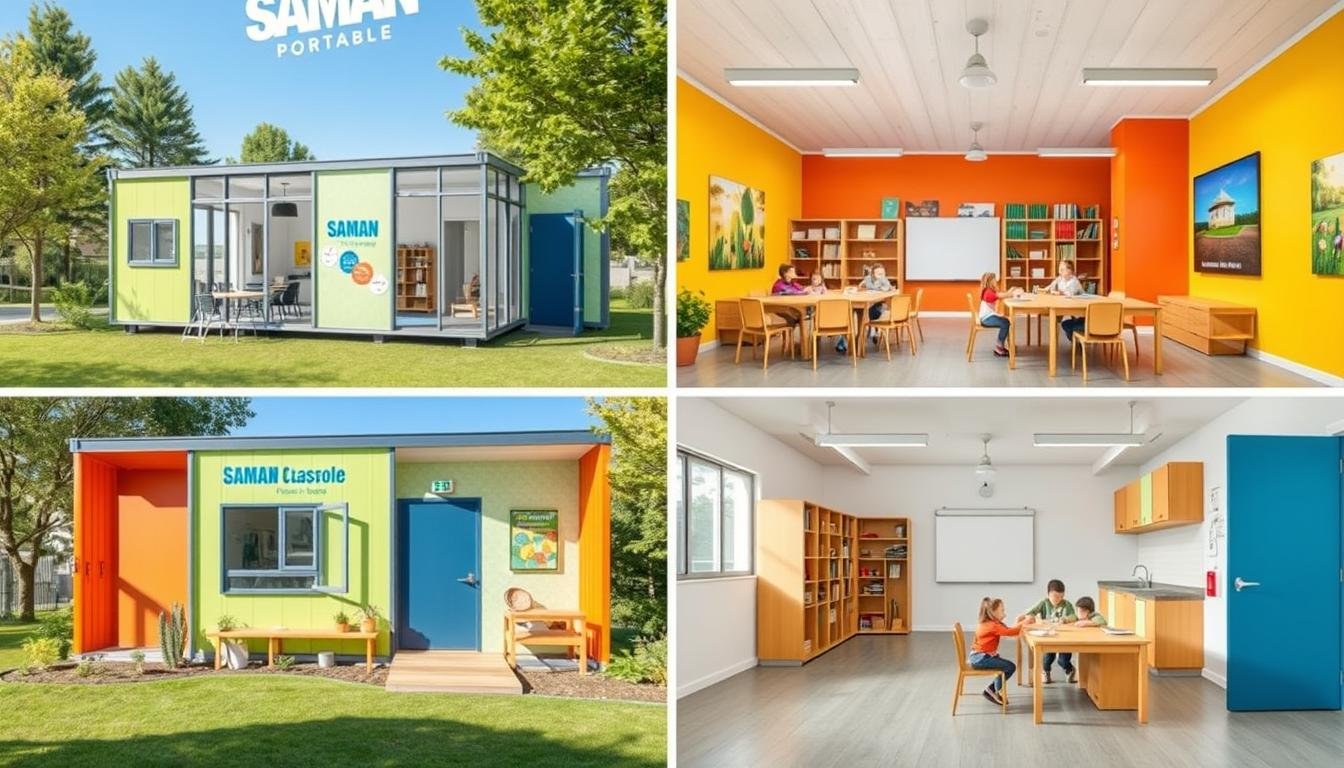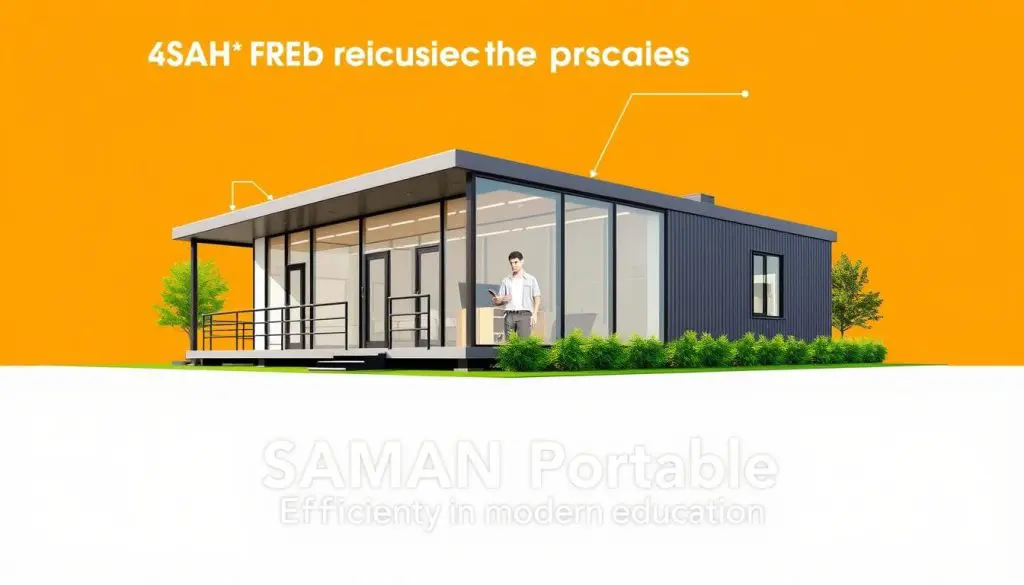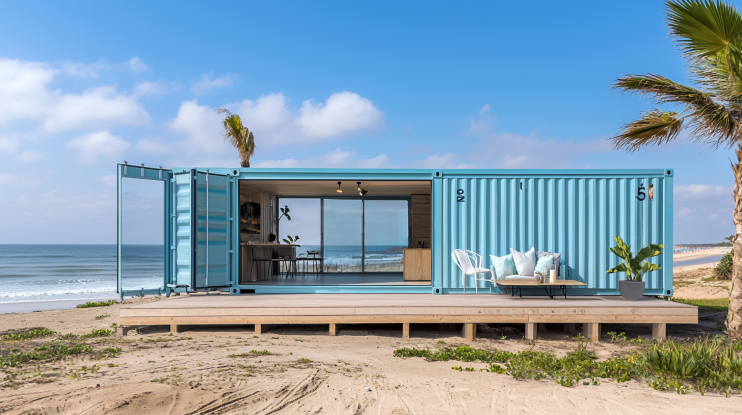Portable Classrooms: Smart, Cost-Effective & Quick Setup Learning Spaces for Schools

Are traditional school buildings becoming outdated in our fast-changing world? Portable classrooms are changing how schools think about learning spaces. They offer flexibility and innovation like never before.
Modern schools have to deal with changing student numbers and tight budgets. Small mobile cabins are a big help. They provide schools with flexible learning areas that can be set up fast and tailored to each school’s needs.
Modular classrooms are more than just temporary buildings. They are designed to give top-notch learning experiences. They also solve infrastructure problems in a smart and affordable way.
Key Takeaways
- Portable classrooms offer rapid deployment within days
- Cost-effective alternative to traditional permanent structures
- Customizable design to meet specific educational requirements
- Energy-efficient and environmentally sustainable
- Adaptable solutions for changing school enrollment dynamics
Evolution of Mobile Learning Environments
The way we learn is changing fast. We’re moving from old classrooms to new, tech-filled learning spaces. These modern portable classrooms offer flexible and innovative ways for schools to teach.
Teachers are now using mobile learning spaces that go beyond old classroom walls. These spaces make learning more fun and tailored to each student.
Traditional to Modern Transition
The move from old classrooms to mobile learning spaces is huge. It’s thanks to big tech advances. Some key changes include:
- More digital content is available
- Less money spent on educational materials
- Learning is more flexible
Integration of Technology
Mobile tiny homes are now being used as new learning spaces. Studies show some interesting facts:
- Almost every household has a smartphone
- Mobile learning lets students learn anytime, anywhere
- Interactive learning keeps students engaged
Adaptive Learning Spaces
Portable houses are turning into dynamic learning areas. The trend shows mobile learning can change education for the better. It makes learning more accessible, interactive, and tailored to each student.
Smartphones are becoming key tools for learning. Schools can create learning environments that meet different student needs. This makes learning more responsive and innovative.
Understanding Portable Classroom Solutions

Portable classrooms are a new way to manage school spaces. They are flexible and efficient, helping schools keep up with changing needs. Unlike old buildings, these homes can be set up fast to meet urgent needs.
The main benefits of using portable homes in schools are:
- Rapid deployment with setup times reduced by 50%
- Customizable configurations to match specific school requirements
- Cost-effective alternatives to permanent construction
- High-quality factory-built construction
Prices for portable houses vary based on size and features. They save a lot of money compared to building from scratch. Schools can pick from single classrooms or bigger setups that hold up to 30 students per room.
Today’s portable classrooms have cool features:
- Full data connectivity
- HVAC systems
- Accessible bathroom facilities
- Advanced A/V equipment
These spaces are very flexible, letting schools adjust fast to new students and learning needs. They can last up to 50 years if built well. This makes them a smart, green choice for schools with limited space.
Benefits of Modular Learning Spaces
Portable buildings are changing how we think about schools. They bring new ideas to learning spaces. Schools all over are seeing the big benefits of High-Quality Portable Cabins.
Today’s schools are turning to Premium Container Offices for smart solutions. These modular spaces offer great value. They come with several key benefits:
- Rapid deployment within 5-14 days
- Up to 50% reduction in building costs
- Customizable to specific educational requirements
- Enhanced student capacity by 10-20%
Cost-Effectiveness and ROI
Portable classrooms are a smart financial choice for schools. They save money without sacrificing quality. Schools can also cut down on utility costs with energy-efficient designs.
Quick Installation Process
Setting up modular learning spaces is fast. Schools can change their classrooms in weeks, not months. This means students get to use modern, flexible spaces sooner.
Flexibility in Design
Portable buildings are great at adapting to new needs. They offer design flexibility that 80% of people prefer. With modern tech like smart screens, these classrooms are ready for the future.
Design Features and Structural Components

Modern portable classrooms are changing education. Custom Porta Cabins solve space problems with smart designs. They use advanced parts to make learning spaces that work well and can change.
The smart design of these classrooms is key. They have:
- Strong frames inspired by shipping containers
- Insulation that works well
- Spaces inside that can change
- Parts that save energy
Prefab Labor Colonies show how good modular building is. Schools get fast, affordable classrooms. Studies show they can be set up in 4-6 weeks, much faster than old ways.
These buildings are also good for the planet. They use less material, cutting waste by half. This makes them green choices. The building process is precise, meeting high safety and quality standards.
They also save money. Modular classrooms cost 20-30% less than usual buildings. This is a smart choice for schools that need to change.
- Quick assembly times
- Reduced construction waste
- Flexible design options
By using these new designs, schools can make better learning spaces. These spaces support new teaching ways while being affordable and green.
Smart Technology Integration in Mobile Classrooms
The digital revolution is changing portable classrooms into advanced learning spaces. The global EdTech market is set to hit USD 333.327 billion by 2027. Now, small mobile cabins are becoming high-tech educational areas that break traditional learning limits.
Modern modular classrooms are more than simple structures. They are now advanced learning centers with top-notch digital setups. Smart technologies are changing how students engage with educational content.
Digital Infrastructure Requirements
Portable classrooms need strong digital systems for new learning experiences. Key parts include:
- High-speed internet connectivity
- Wireless networking capabilities
- Secure cloud storage systems
- Advanced power management solutions
Interactive Learning Tools
Smart technologies are changing education in modular classrooms. Tools like smart boards make learning interactive through:
- Touch-based interaction technologies
- Real-time data manipulation
- Cross-device compatibility
- On-screen editing features
Connectivity Solutions
The Indian Smart Classrooms Market is expected to reach USD 16.11 billion by 2026. This shows how important connectivity is. IoT systems connect classroom resources, making learning smooth and effective for:
- Automated attendance tracking
- Interactive whiteboard technologies
- Personalized learning experiences
- Global course participation
The future of education is here, and portable classrooms are leading the technological transformation.
Environmental Impact and Sustainability
The education sector is seeing a big change with green portable classrooms. Schools are now using eco-friendly learning spaces. These spaces cut down on environmental harm while meeting educational needs.
Modular construction for portable classrooms has big environmental benefits:
- Construction waste is less than 5% sent to landfills
- Energy use drops by up to 40% compared to old buildings
- They are built faster, with 50% less time needed
Portable houses for schools focus on being green. They use the latest green tech to make learning spaces better.
Important green features include:
- High-performance thermal insulation
- LED lighting systems
- Support for renewable energy
- Use of recycled and eco-friendly materials
Choosing portable classrooms helps schools cut down on carbon emissions. They also create modern, flexible learning spaces. These spaces inspire students and support learning about the environment.
Safety Standards and Compliance Requirements
Keeping students safe is the top priority in portable homes and houses used for schools. The rules for portable classrooms are complex and go beyond just building them.
Building Codes and Regulations
Portable classrooms must follow strict rules from local and national building codes. The Texas Education Code sets clear safety standards for these buildings.
- Structural integrity verification
- Compliance with local building codes
- Regular inspection protocols
Health and Safety Measures
Portable houses for schools need strong safety measures. Schools must have many safety features to protect everyone.
- Access control systems
- Communication devices for emergency contact
- Proper locking mechanisms
Quality Control Protocols
Keeping high standards means following strict quality control steps. Every part of portable homes, from electrical to ventilation, is checked carefully.
- Electrical safety compliance (BS 7671 standards)
- Fire detection and prevention systems
- Regular maintenance inspections
The cost of a portable house includes its safety features. With strict rules and advanced safety, portable classrooms are a safe and flexible option for schools.
Customization Options for Educational Spaces

Turning portable buildings into lively learning spots is now a key skill for schools. High-Quality Portable Cabins offer great flexibility. This lets schools make spaces that fit their changing needs.
Premium Container Offices have changed classroom design for schools. They offer amazing customization options. This lets schools create spaces that spark creativity and keep students engaged.
- Specialized Learning Areas: Make areas just for STEM, arts, and group projects
- Integrated Technology Solutions: Add smart boards, interactive displays, and better connectivity
- Flexible Layouts: Use movable walls and changeable spaces
- Ergonomic Design: Choose furniture that’s good for students and easy to move
Key features for customization include:
- Modular design for easy changes
- Energy-saving windows and lights
- Advanced sound treatments
- Storage and tech setup built right in
Schools can now design spaces that break free from old classroom limits. Portable buildings help create an experience that evolves with your school’s needs.
Statistics show a big shift: 20% of schools use temporary spaces now. This shows a growing need for flexible, changeable learning areas that fit new teaching methods.
Cost Analysis: New vs Used Portable Classrooms
Choosing between new and used portable classrooms is a big decision. School leaders must weigh costs carefully. They look for ways to make learning spaces affordable.
Purchase Options: Strategic Investment Approaches
Your school has several ways to get portable classrooms. Here’s what you need to know:
- Buying a used single-wide portable classroom costs about $120,000
- A new single-wide portable classroom costs $31,251
- After 5 years, you can sell it for up to 75% of what you paid
Leasing Solutions: Flexible Funding Strategies
Leasing is a flexible way for schools to get portable classrooms. Here are some important points:
- Leasing a 24’x60′ portable classroom costs $2,800 a month
- The total cost for 36 months is $100,800
- Returning the unit costs about $4,300
Long-term Investment Benefits
Smart schools see portable classrooms as more than temporary solutions. They offer long-term benefits:
- Asset Creation: Buying creates lasting educational spaces
- ROI can be seen in 4-9 years
- They can be moved or expanded in the future
Your choice should match your budget, enrollment, and educational plans.
Applications Across Different Educational Settings
Portable classrooms have changed how we think about schools. They bring flexibility to places where space is tight. This helps schools manage their space better and teach in new ways.
Different schools use modular classrooms in amazing ways:
- Urban Schools: They help with space problems in busy cities.
- Rural Institutions: They offer affordable ways to build schools.
- Special Education Centers: They create special learning areas.
- Technical Training Facilities: They support specific training programs.
Portable classrooms are not just for schools. They let schools quickly change to meet new needs without spending a lot of money.
Here are some interesting facts about these flexible learning spaces:
- By 1999, 36% of schools used portable classrooms.
- 20% of schools set up temporary classrooms.
- Building with modules can save a lot of money.
These spaces are used in all kinds of schools. They help with basic subjects and advanced STEM and arts programs. Portable classrooms are a smart choice for today’s schools.
Maintenance and Durability Considerations
Buying portable classrooms means knowing how to keep them up. These spaces are made to last and adapt to different learning needs.
Regular Upkeep Requirements
Keeping portable classrooms in good shape is key. Here are some important steps:
- Routine structural inspections
- Resealing and repainting exterior surfaces
- Checking HVAC systems regularly
- Monitoring ventilation and air quality
Longevity Factors
The life of mobile tiny homes and portable houses depends on a few things. Using top-notch materials like pressure-treated wood helps a lot. Also, making them with care means fewer problems later on.
Weather Resistance Features
Portable classrooms face many weather challenges. They’re built to handle these with:
- Robust insulation systems
- Weatherproof exterior coatings
- Engineered anchoring methods
- Climate-specific structural adaptations
With the right care, schools can make their portable classrooms last. This ensures students learn in a safe and effective way for many years.
Installation Process and Timeline
Turning empty spaces into learning areas is quick with portable classrooms. These innovative houses change how schools get ready for classes fast.
The time it takes to set up a portable home depends on a few things:
- Site preparation complexity
- Building size and configuration
- Weather conditions
- Utility connection requirements
A standard portable classroom can be set up fast. A 24′ x 60′ modular classroom might be ready in just one day under optimal conditions. Bigger buildings take longer, usually a week, because of more work needed.
Here are the main steps to install a portable house:
- Site survey and preparation
- Foundation setup
- Module delivery
- Precise positioning and connection
- Utility integration
- Final inspections
The cost of a portable house is worth it for how fast it’s set up. Most are ready in 8 weeks from start to finish. This means schools can quickly meet their space needs.
Things like a level site and planned utility connections help set up faster. Portable houses offer flexibility without losing quality or learning environment standards.
Financing Options and Budget Planning
Getting portable classrooms can be tricky, but there are ways to make it easier. Schools can now find flexible financing options. This makes getting High-Quality Portable Cabins more accessible than before.
When looking at Premium Container Offices for schools, there are several financial paths to explore:
- Operating Leases: Short-term rental options with lower upfront costs
- Finance Leases: Lease-to-own arrangements for long-term ownership
- Cooperative Purchasing Contracts: Cost-sharing opportunities with other institutions
- Grant-based Financing: Funding from educational development programs
Budget planning is more than just the initial cost. Schools need to think about long-term maintenance, expansion, and value. Portable buildings are cost-effective, with faster installation and lower prices than permanent structures.
Important financial points to consider include:
- Initial acquisition costs
- Maintenance expenses
- Potential resale or relocation value
- Energy efficiency savings
By looking at these financing strategies, schools can make smart choices. This helps them use their budget wisely and create top-notch learning spaces.
Conclusion
Portable classrooms are changing how schools think about space and money. Custom Porta Cabins offer a flexible and affordable way to grow. They help schools quickly meet the need for more classrooms.
The future of learning spaces is all about being adaptable and smart. Prefab Labor Colonies show how to build quality classrooms fast and cheap. Schools can now easily change their classrooms to fit new needs and ideas.
Stylish Container Cafes and portable classrooms are leading the way in new learning spaces. They save up to 50% on costs, set up fast, and can grow or move as needed. These spaces are designed to be tech-friendly and customizable, helping schools create inspiring places for learning.
In the end, portable classrooms are more than a quick fix. They are a smart way to build schools for today and tomorrow. By using these innovative spaces, schools can create places that are both efficient and inspiring for 21st-century learning.
FAQ
How quickly can a portable classroom be installed?
Portable classrooms can be set up quickly, usually in a few weeks. This is much faster than traditional building methods. They are made off-site and designed to be modular, which speeds up delivery and setup.
Are portable classrooms as safe as traditional school buildings?
Yes! Portable classrooms meet strict safety standards. They go through detailed checks for fire safety, structure, and health. This ensures they are as safe as permanent buildings.
What are the cost benefits of choosing portable classrooms?
Portable classrooms save money in many ways. They cost less to start, take less time to build, and need little site prep. They also offer flexible payment plans. This makes them a cost-effective choice for schools.
Can portable classrooms be customized to specific educational needs?
Yes! Today’s portable classrooms can be tailored to fit different educational needs. They can have movable walls, tech integration, and special storage. This creates unique learning spaces that meet specific requirements.
How environmentally friendly are portable classrooms?
Portable classrooms are surprisingly green. Building them off-site cuts down on waste. They often use energy-saving designs and materials. This makes them a good choice for schools looking to be more eco-friendly.
What technology can be integrated into portable classrooms?
Modern portable classrooms are equipped with the latest tech. They have fast internet, smart boards, and interactive tools. They also support virtual reality and have the electrical systems needed for advanced technology.
How long do portable classrooms typically last?
With care, portable classrooms can last 20-30 years. They are made with durable materials and weather-resistant features. This ensures they can withstand different conditions for a long time.
Are there financing options available for portable classrooms?
Yes, there are many financing options. Schools can buy them outright, lease, or rent-to-own. There are also grants available. This allows schools to find a payment plan that fits their budget.
Can portable classrooms be used in different educational settings?
Absolutely! Portable classrooms are very versatile. They can be used in K-12 schools, colleges, remote learning centers, and even temporary facilities during renovations.
How quickly can a school receive a portable classroom after ordering?
Portable classrooms can be delivered and set up in 8-12 weeks. This is fast, making them a great choice for schools that need space quickly or have unexpected growth.
 Container Cafe
Container Cafe




















































































